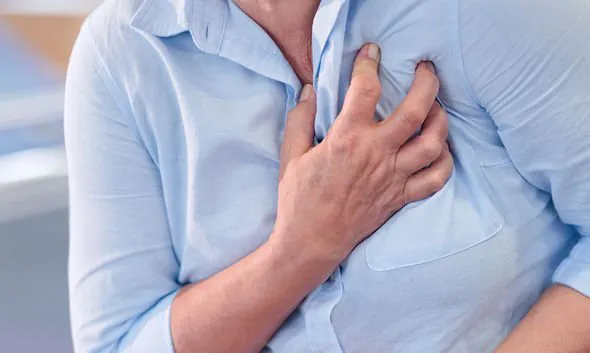Heart attack warning - the rash on your foot that could be a sign of deadly heart disease
HEART attack symptoms include difficulty breathing, severe chest pain, and feeling sick. But, you could also be at risk of a deadly myocardial infarction and heart disease if you develop a tell-tale painful rash on your foot. Should you consider speaking to a doctor about heart attack signs?
Heart attacks are serious medical emergencies that require immediate attention from a doctor. You could be at risk of a deadly heart attack - or myocardial infarction - if you develop an unusual rash on your foot, it's been claimed.
Heart attacks are caused by a lack of blood reaching the heart.
Without enough blood, the heart could become seriously damaged - and it may even be life-threatening.
A heart attack could also be a symptom of coronary heart disease, which is where fatty deposits build up in the arteries, which limits the amount of blood reaching the heart.
One of the key warning signs of a heart attack is developing an unexplained discolouration on your feet, it's been revealed.
Heart attack symptoms: Signs of heart disease on your feet include spots and rash
The discolouration usually appears as a group of brown or red spots, according to the American Academy of Dermatology (AAD).
The spots, which are usually completely painless, may seem like large bruises underneath the skin.
They're most usually spotted on the underside of the feet, although they may also appear on the palms of your hands.
The rash is officially known as 'Janeway lesions', and it's usually a sign of an infection in the heart, which raises the risk of heart disease.
"Warning signs can appear on your skin and nails, which is why your dermatologist may be the first doctor to notice that you have heart disease," said the AAD.
"If you know what to look for, you can also find warning signs of heart disease on your skin and nails.
"Brownish [or reddish] discolouration, usually on your sole(s) or palm(s) - what it may be telling you: You have an infection in your heart or blood vessel.
"The spots that developed on the bottom of this patient’s foot are also a sign of a heart infection called infective endocarditis. Unlike Osler nodules, these spots are painless. These spots will clear without treatment, usually in a few days or weeks. The infection requires treatment."

Heart attack symptoms: Chest pain could be a warning sign of a heart attack
READ MORE

Heart attack symptoms - does your jaw feel like this? The painful sign
Meanwhile, you could also be at risk of a heart attack if you regularly have indigestion.
Indigestion may feel like a pain in your stomach, or feeling full or bloated.
It's caused by a radiating pain from a heart attack, which can also affect the chest, arms or back.
If your indigestion is caused by a heart attack, it's unlikely to be accompanied by belching or nausea.
READ MORE

Meanwhile, the most common heart attack signs include severe chest pain, having a radiating pain in your arm, and suddenly feeling very dizzy.
But you can lower your risk of a heart attack by making some small diet or lifestyle changes.
Eating a healthy, balanced diet will lower your chances of fatty deposits in your arteries.
If you think you, or someone you know, may be having a heart attack, it's crucial that you dial 999 straight away.
Heart attacks are serious medical emergencies that require immediate attention from a doctor. You could be at risk of a deadly heart attack - or myocardial infarction - if you develop an unusual rash on your foot, it's been claimed.
Heart attacks are caused by a lack of blood reaching the heart.
Without enough blood, the heart could become seriously damaged - and it may even be life-threatening.
A heart attack could also be a symptom of coronary heart disease, which is where fatty deposits build up in the arteries, which limits the amount of blood reaching the heart.
One of the key warning signs of a heart attack is developing an unexplained discolouration on your feet, it's been revealed.
The discolouration usually appears as a group of brown or red spots, according to the American Academy of Dermatology (AAD).
The spots, which are usually completely painless, may seem like large bruises underneath the skin.
They're most usually spotted on the underside of the feet, although they may also appear on the palms of your hands.
The rash is officially known as 'Janeway lesions', and it's usually a sign of an infection in the heart, which raises the risk of heart disease.
"Warning signs can appear on your skin and nails, which is why your dermatologist may be the first doctor to notice that you have heart disease," said the AAD.
"If you know what to look for, you can also find warning signs of heart disease on your skin and nails.
"Brownish [or reddish] discolouration, usually on your sole(s) or palm(s) - what it may be telling you: You have an infection in your heart or blood vessel.
"The spots that developed on the bottom of this patient’s foot are also a sign of a heart infection called infective endocarditis. Unlike Osler nodules, these spots are painless. These spots will clear without treatment, usually in a few days or weeks. The infection requires treatment."

Heart attack symptoms: Chest pain could be a warning sign of a heart attack
READ MORE

Heart attack symptoms - does your jaw feel like this? The painful sign
Meanwhile, you could also be at risk of a heart attack if you regularly have indigestion.
Indigestion may feel like a pain in your stomach, or feeling full or bloated.
It's caused by a radiating pain from a heart attack, which can also affect the chest, arms or back.
If your indigestion is caused by a heart attack, it's unlikely to be accompanied by belching or nausea.
READ MORE

Heart attack symptoms: The 'unusual' symptom you could easily miss
Meanwhile, the most common heart attack signs include severe chest pain, having a radiating pain in your arm, and suddenly feeling very dizzy.
But you can lower your risk of a heart attack by making some small diet or lifestyle changes.
Eating a healthy, balanced diet will lower your chances of fatty deposits in your arteries.
If you think you, or someone you know, may be having a heart attack, it's crucial that you dial 999 straight away.





0 Response to "Heart attack warning - the rash on your foot that could be a sign of deadly heart disease"
Post a Comment